威纶通触摸屏选型手册
- 格式:pdf
- 大小:7.86 MB
- 文档页数:61
![威伦触摸屏软件使用方法[指南]](https://uimg.taocdn.com/bbe3b9facf84b9d529ea7aa9.webp)
威伦触摸屏软件使用方法[指南] 威伦触摸屏软件EasyBuilder 500使用方法安装好EB500软件后,在[开始]中选择[程序]/[EasyBuilder]/[EasyBuilder 500]。
一、建立新的工程文件选择菜单“文件\新建”,在类型选择对话框中选择人机界面的产品型号:MT506T/C/M(320×234),显示模式为水平,语言为东方语言。
新文件建立之后“确定”即可进入主界面。
主界面外观如图所示,界面分为几个区:菜单条(包含9个主菜单项)、工具条(快捷按钮和选择项)、画图工具条、窗口选择列表框、元件工具条等。
除菜单条和窗口画面外,用户可根据需要决定其他的取舍。
为实现威伦触摸屏RS232端口与FX2N-232BD模块RS232口通讯,在菜单条选择“编辑/系统参数”,进入系统参数设置对话框,点击“PLC设置”,选择PLC 机型、通讯口类型及通讯参数,如下图所示。
完成后“确定”。
PLC端设置:新建工程后,点击左边工程数据列表中的参数选项—PLC参数(双击进入),点击PLC系统(2)菜单按下图设置。
设置完成后就可正常的编写PLC程序,在进行程序下载(写入PLC)时,选择PLC参数选项将刚设置好的参数一并下载。
以后改变PLC程序后下载时就不再选择PLC参数选项。
二、窗口画面设定窗口是EB500的工程的基本元素。
每个屏幕都是由一些窗口组成。
窗口有3种类型:基本窗口,公用窗口和快选窗口。
改变大小以后的基本窗口还可以当作弹出窗口使用。
所有的窗口都可以作为底层窗口。
基本窗口是通常窗口的类型。
当用”切换基本窗口”命令来切换基本窗口时,当前屏幕会清屏(除了公用窗口和快选窗口之外的窗口都会被清掉),而要切换的基本窗口会显示在当前屏幕上。
当基本窗口上的元件调用弹出窗口时,基本窗口的原始信息会保留,而调用的弹出窗口会附加到当前基本窗口上,所有的这样的弹出窗口与基本窗口都是父子窗口的关系。
当从基本窗口N切换到基本窗口M时,所有窗口N的子窗口都将关闭,而显示窗口M和窗口M的子窗口。
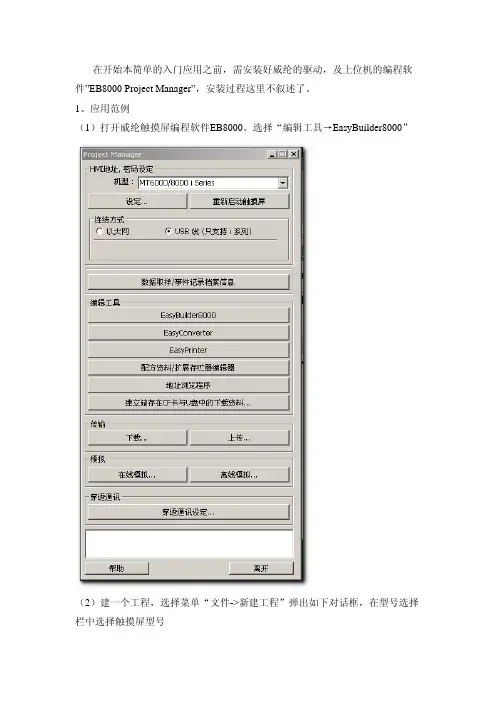
在开始本简单的入门应用之前,需安装好威纶的驱动,及上位机的编程软件”EB8000 Project Manager”,安装过程这里不叙述了。
1、应用范例(1)打开威纶触摸屏编程软件EB8000。
选择“编辑工具→EasyBuilder8000”(2)建一个工程,选择菜单“文件->新建工程”弹出如下对话框,在型号选择栏中选择触摸屏型号(3)按下“确定”按钮后,弹出如下对话框接口类型选择“RS-232”,PLC预设站号需要和子站设置相匹配匹配(5)按下“确定”按钮,弹出如下画面(6)选择“文件->另存为”先保存该工程。
也可在后面再保存。
灯→位状态指示灯”添加如下指示灯(BL_0)图案→位状态设置”添加如下开关(SB_0)图案(9)选择“文字添加”按钮,在画面添加WW0字样,再选择菜单“元件→数字/字元→数值显示”添加如下显示框(ND_0)图案(10)选择“文字添加”按钮,在画面添加DD0字样,再选择菜单“元件→数字/字元→数值输入”添加如下输入框(NE_0)图案(11)选择“元件/资料取样”后弹出资料取样对话框(12)按下“新增”按钮,在PLC名称选择PLC,设备类型以及地址选择4*42014(PLC例子程序中将PLC_R112数值对应到DW13),再按下“确定”按钮(13)选择“文字添加”按钮,在画面添加调节R112改变数值字样,再选择菜单“元件→趋势图”添加如下显示框(TD_0)图案(14)点击画面中I0.0所对应“BL0“控件,地址类型中选取1x(离散输入),地址栏中填写I0.0在PLC中对应的Modbus-RTU地址10001(威纶中地址编址从1开始,所以I0.0地址为10000+1)(15)点击画面中Q0.0所对应“SB_0“控件,地址类型中选取0x(离散输出),地址栏中填写Q0.0在PLC中对应的Modbus-RTU地址1(威纶中地址编址从1开始,所以Q0.0地址为00000+1),在开关类型下拉菜单中选择切换开关。
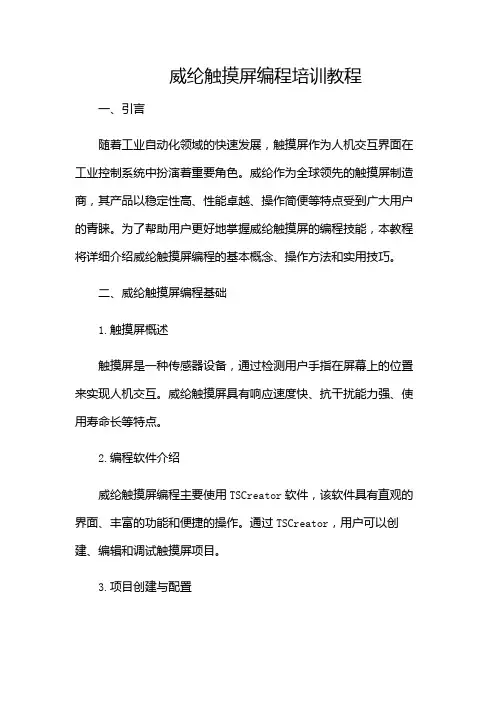
威纶触摸屏编程培训教程一、引言随着工业自动化领域的快速发展,触摸屏作为人机交互界面在工业控制系统中扮演着重要角色。
威纶作为全球领先的触摸屏制造商,其产品以稳定性高、性能卓越、操作简便等特点受到广大用户的青睐。
为了帮助用户更好地掌握威纶触摸屏的编程技能,本教程将详细介绍威纶触摸屏编程的基本概念、操作方法和实用技巧。
二、威纶触摸屏编程基础1.触摸屏概述触摸屏是一种传感器设备,通过检测用户手指在屏幕上的位置来实现人机交互。
威纶触摸屏具有响应速度快、抗干扰能力强、使用寿命长等特点。
2.编程软件介绍威纶触摸屏编程主要使用TSCreator软件,该软件具有直观的界面、丰富的功能和便捷的操作。
通过TSCreator,用户可以创建、编辑和调试触摸屏项目。
3.项目创建与配置(1)启动TSCreator,“新建项目”按钮,设置项目名称、屏幕尺寸等参数。
(2)在项目树状图中,右键“屏幕”,选择“添加新屏幕”,设置屏幕属性。
(3)在屏幕编辑区,通过拖拽控件到屏幕上,实现界面设计。
(4)双击控件,设置控件属性,如变量绑定、事件响应等。
4.变量与脚本(1)变量:用于存储和传递数据的容器。
在TSCreator中,可以创建各种类型的变量,如整数、实数、字符串等。
(2)脚本:触摸屏编程的核心,用于实现复杂的逻辑控制和数据处理。
TSCreator支持JavaScript脚本语言。
5.事件与函数(1)事件:触摸屏编程中的触发器,当用户操作屏幕或变量发生变化时,会产生相应的事件。
(2)函数:用于执行特定任务的代码块。
在TSCreator中,可以自定义函数,实现个性化的功能。
三、威纶触摸屏编程实践1.界面设计(1)根据实际需求,设计触摸屏界面,包括按钮、文本框、图表等控件。
(2)设置控件属性,如字体、颜色、大小等。
(3)通过脚本实现动态界面效果,如动画、滚动等。
2.数据处理(1)创建变量,用于存储设备运行数据。
(2)编写脚本,实现数据的读取、计算和显示。
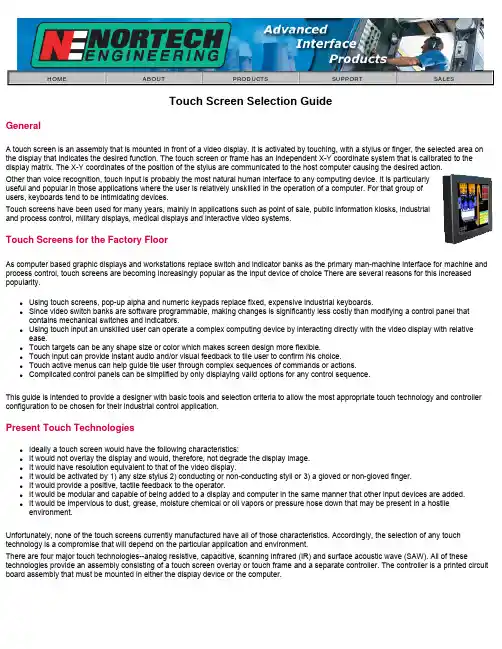
HOME ABOUT PRODUCTS SUPPORT SALESTouch Screen Selection GuideGeneralA touch screen is an assembly that is mounted in front of a video display. It is activated by touching, with a stylus or finger, the selected area on the display that indicates the desired function. The touch screen or frame has an independent X-Y coordinate system that is calibrated to the display matrix. The X-Y coordinates of the position of the stylus are communicated to the host computer causing the desired action.Other than voice recognition, touch input is probably the most natural human interface to any computing device. It is particularlyuseful and popular in those applications where the user is relatively unskilled in the operation of a computer. For that group ofusers, keyboards tend to be intimidating devices.Touch screens have been used for many years, mainly in applications such as point of sale, public information kiosks, industrialand process control, military displays, medical displays and interactive video systems.Touch Screens for the Factory FloorAs computer based graphic displays and workstations replace switch and indicator banks as the primary man-machine interface for machine and process control, touch screens are becoming increasingly popular as the input device of choice There are several reasons for this increased popularity.q Using touch screens, pop-up alpha and numeric keypads replace fixed, expensive industrial keyboards.q Since video switch banks are software programmable, making changes is significantly less costly than modifying a control panel that contains mechanical switches and indicators.q Using touch input an unskilled user can operate a complex computing device by interacting directly with the video display with relative ease.q Touch targets can be any shape size or color which makes screen design more flexible.q Touch input can provide instant audio and/or visual feedback to tile user to confirm his choice.q Touch active menus can help guide tile user through complex sequences of commands or actions.q Complicated control panels can be simplified by only displaying valid options for any control sequence.This guide is intended to provide a designer with basic tools and selection criteria to allow the most appropriate touch technology and controller configuration to be chosen for their industrial control application.Present Touch Technologiesq Ideally a touch screen would have the following characteristics:q It would not overlay the display and would, therefore, not degrade the display image.q It would have resolution equivalent to that of the video display.q It would be activated by 1) any size stylus 2) conducting or non-conducting styli or 3) a gloved or non-gloved finger.q It would provide a positive, tactile feedback to the operator.q It would be modular and capable of being added to a display and computer in the same manner that other input devices are added.q It would be impervious to dust, grease, moisture chemical or oil vapors or pressure hose down that may be present in a hostile environment.Unfortunately, none of the touch screens currently manufactured have all of those characteristics. Accordingly, the selection of any touch technology is a compromise that will depend on the particular application and environment.There are four major touch technologies--analog resistive, capacitive, scanning infrared (IR) and surface acoustic wave (SAW). All of these technologies provide an assembly consisting of a touch screen overlay or touch frame and a separate controller. The controller is a printed circuit board assembly that must be mounted in either the display device or the computer.Analog ResistiveAnalog resistive screens consist of a sandwich of Mylar and plastic or glass. Usually the Mylar overlay is hard coated to resist abrasion. The two layers are separated from each other by transparent elastic spacer dots. The inside surfaces of the sandwich are coated with a uniform transparent thin film conductive coating, usually indium-tin-oxide (ITO). In operation, a voltage is alternately applied along the horizontal and vertical axes. When the Mylar overlay is depressed and its conductive layer makes contact with the energized layer, that voltage is sensed and transmitted to a controller containing an analog-to-digital converter. The voltage is converted to a digital X or Y touch location. Although the basic analog resistive technology has infinite resolution, the actual system resolution is limited to the resolution of the A-D converter and is generally greater than 1,000x1,000 points.CapacitiveA cross section of a capacitive screen is shown. A glass panel is coated with a conductive coating(usually ITO) that is fused into the glass. The coating is connected to four electrodes at the edges of thescreen. Each electrode is connected to an oscillator circuit. When an operator touches the screen, thebody capacitance of the operator causes a change in the impedance of the screen. The impedancechange causes the oscillator frequencies to vary, and the frequency differentials are converted into X-Ycoordinates by an A-D converter. As with the analog resistive screen, the basic capacitive screen hasinfinite resolution but the system resolution is limited by the signal-to-noise ratio which puts a practicalupper limit on the A-D converter resolution--typically 1,000x 1,000 points.Scanning Infrared (IR)The IR technology is the onlytechnology that does not overlay thedisplay with an additional screen orscreen sandwich. An array of infrared (IR) light emitting diode (LED)/photodetector pairs are mounted in a plastic frame. Using the IR spectrum allowsambient light to be filtered out and makes possible the use of opaque (to thevisible spectrum) plastic frames to hide the photo devices. Thus, the arrayframe simply looks like a bezel. In operation, the LED/photo detector array iscontinuously and sequentially scanned horizontally and then vertically Whenan operator touches the display breaking one or more of the light beams, the X-Y position of the touch stylus is transmitted to the host computer. Themaximum resolution using an interpolation technique is approximately doublethe number of LED/photo detector pairs in the array. Using interpolation, whenan odd number of beams is broken along either axis, the X or Y coordinate ofthe center beam is transmitted, but when an even number of beams is broken,the coordinates of the interpolated beam are calculated and transmitted to thehost computer.Surface Acoustic Wave (SAW)The surface acoustic wave technology is the latest of the touch input technologies and uses inaudible acoustic waves traveling over the surface ofa glass panel at precise speeds in straight lines. X and Y transmittingtransducers are located along the horizontal and vertical edges of a glass plate.Corresponding X and Y receiving transducers are located at the opposite edgesof the glass plate. A reflective array made of powdered glass is printed along theedges of the glass plate. The array consists of .2 mil thick by 1/2 inch widediagonal, parallel lines. In operation, the transducer generates a surfaceacoustic wave which travels along the axis of the reflector array. At eachreflector element, a small amount of the energy in the wave is deflectedorthogonally to the direction of the wave, travels over the surface of the glassand is again deflected orthogonally toward the receiving transducer by a mirrorimage reflector. Since the energy in the wave is reduced as it travels the lengthof the reflective array, the reflector elements are placed increasingly closertogether to compensate for the decreasing energy level. When an operatortouches the screen, a portion of the energy is absorbed by the touch stylus. Thisreduced energy level is detected and, by comparing the speed of the receivedsignal with the known speed of the SAW on glass, an X or Y coordinate locationis registered. As with capacitive screens, the basic SAW technology has infiniteresolution but is limited by the signal-to-noise ratio which puts a practical limit onthe A-D converter--typically 900x900 coordinate locations.Touch Screen ControllersMost manufacturers offer two controller configurations--ISA Bus and Serial-RS232.q ISA bus controllers are contained on a standard printed circuit plug-in board and can only be used on ISA or EISA PCs. Depending on the manufacturer they may be interrupt driven, polled or be configured as another serial port.q Serial controllers are contained on a small printed circuit board and are usually mounted in the video monitor cabinet. They are then cabled to a standard RS232 serial port on the host computer.SoftwareMost touch screen manufacturers offer some level of software support which include mouse emulators, software drivers, screen generators and development tools for Windows, OS/2, Macintosh and DOS.Most of the supervisory control and data acquisition (SCADA) software packages now available contain support for one or more touch technologies.Selection ProcessGenerally there four factors that must must considered for any touch screen application:q The basic touch technologyq The touch controller configurationq The screen surface treatment (not applicable to IR touch screens)q Compatibility with the applications softwareTouch Technology Evaluation Factorsq Resolution-- The smallest detectable increment of stylus movement establishes the touch resolution. Low resolution may be adequate to activate large targets but for mouse tracking or small target activation, resolution equivalent to that of the monitor is desirable.q Parallax-- If a significant variance exists between the target position on the CRT and the point on the touch screen matrix that, when activated by a stylus, causes a touch to be registered the operator could select a different target area than the desired target.q Environment-- The buildup of a layer of dust, oil, grease or any foreign substance on fingers, harsh chemical vapors and hose-down by pressure hoses may cause improper touch operation.q Stylus-- Types of styli typically used with touch screens are bare finger and gloved finger. Occasionally other types of styli including pencil erasers, tips of a pen, may be pointed at the screen and the user expects a responseq Transmissivity-- Overlay touch screens act as a neutral density filter and, therefore attenuate the light from the CRT.q Abrasion-- Touch screen abrasion is experienced in one of three ways. 1) Cleaning of screen with an abrasive 2) Impacting the screen witha sharp object 3) Gradual wearing of the screen from repeated useTouch Technology Selection CriteriaAnalog ResistiveAdvantagesq Highest resolution (better than 1 K x 1 K), smooth mouse tracking and small target activationq Will operate with virtually any stylus including gloved/ungloved fingersq Low parallax with spherical screen that conforms to CRT faceplateq Impervious to dust, oils, grease, moistureq Touch has some tactile feedbackDisadvantagesq Although Mylar overlay has a hard coat and is somewhat abrasion resistant, it can be damaged by gouging from a sharp instrument q Hose down can cause unwanted activation of target areasq Lowest transmissivity of all touch technologies - 55%-65%CapacitiveAdvantagesq High resolution - 1 K x 1 K, smooth mouse tracking and small target activationq Low parallax with spherical screen that conforms to CRT faceplateq Impervious to dust, oils, grease, moistureq Hose-down does not cause unwanted activation of targetsq Impervious to scratching by all but the hardest materialsq High transmissivity - >85%Disadvantagesq Will not respond to gloved finger or any non-conductive stylusScanning Infrared (IR)Advantagesq Best image quality as there is no overlayq Impervious to scratchingq Activates with gloved or ungloved finger and any stylus that is large enough to break IR light beam (typically >.25") Disadvantagesq Low resolutionq Exhibits worst parallax problem of all technologies for CRT use since light beams do not follow curvature of CRT faceplate q May cause unintended activation of target prior to finger contact with CRT caused by IR light beam location above surface of CRT q Pressure hose down may cause unwanted target selectionq Dust, oil or grease buildup on frame that impedes light beam may cause malfunctionSurface Acoustic Wave (SAW)Advantagesq High transmissivity - >92%q High resolution - 900 x 900, smooth mouse tracking and small target activationq Low parallax with spherical screen that conforms to CRT faceplateq Impervious to scratching by all but the hardest materialsq Only technology with Z axis controlDisadvantagesq Pressure hose down may cause unwanted target selectionq Dust, oil or grease on surface of touch screen may cause malfunction or unwanted target selectionTouch Controller Selection CriteriaBus Controllerq Bus controllers are available for ISA/EISA and Micro channel. For any other bus, a serial controller must be usedq Bus controllers usually take a half-length slotq Bus controllers can only be driven a few feet. Therefore the distance between the video monitor and computer must be relatively short q Certain designs are interrupt driven and require the assignment of an IRQ line. Others have a serial port format and require the assignment of a COM port.q Bus controllers are mechanically easier to install.Serial ControllersSerial Controllers are necessary if:q A computer bus other than ISA/EISA or Micro channel is usedq A computer slot is not available but a serial port is availableq There is a separation between the computer and monitor of several feet or moreq No IRQ line is availableSurface Treatment Selection CriteriaTwo types of surface treatment are offered for most overlay screens - clear and anti-glareq Anti-glare screens use an etched surface to diffuse reflected light thus scattering specular reflected light and reducing glare. Unfortunately, this also causes some diffusion of the image. The diffusion is limited if the screen is close to the display surface, but some diffusionremains.q Clear screens have no diffusion of the display image but the screen is highly reflectiveThe choice of clear or anti-glare may be somewhat affected by the intensity and direction of ambient light in the viewing area, but in the final analysis, it is usually a subjective decisionSoftware CompatibilityAfter the touch screen technology and controller have been selected:q It is necessary to determine that the software drivers supplied with the touch screen are compatible with tile latest version of the user's operating systemq If standard application software is being considered. it is necessary to determine that the software is compatible with the drivers and touch hardwareq If software is being developed, it is necessary to ascertain that adequate software drivers and development tools are available SummaryWe have shown that there are many factors to consider in the proper selection of a touch screen, primarily focused on the application and the environment in which it will be used. We have attempted to provide the designer with adequate information to make an informed choice of a touch screen technology that best suits the application.Nortech offers a complete line of touch input workstations, control stations and video monitors. Analog resistive and capacitive touch screens are offered as standard products, since one or the other will best satisfy most industrial control applications for use with CRTs. For generally clean environments, surface acoustic wave (SAW) touch screens may be substituted, if desirable. Nortech does not support scanning infrared (IR) touch screens for use with CRTs.Copyright 1996-2006, Nortech Engineering, Inc., All Rights Reserved。
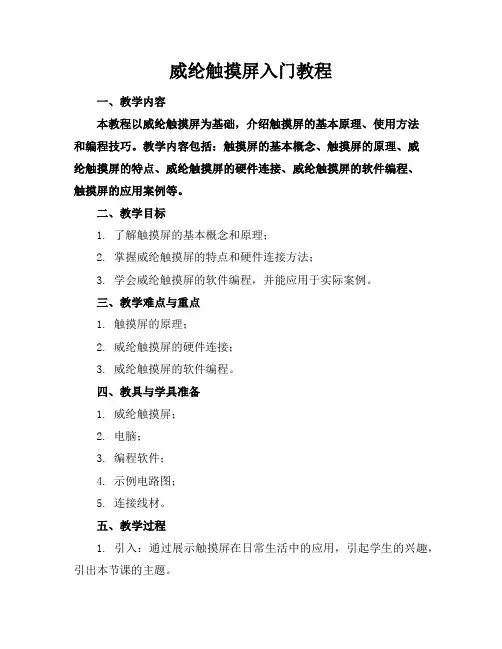
威纶触摸屏入门教程一、教学内容本教程以威纶触摸屏为基础,介绍触摸屏的基本原理、使用方法和编程技巧。
教学内容包括:触摸屏的基本概念、触摸屏的原理、威纶触摸屏的特点、威纶触摸屏的硬件连接、威纶触摸屏的软件编程、触摸屏的应用案例等。
二、教学目标1. 了解触摸屏的基本概念和原理;2. 掌握威纶触摸屏的特点和硬件连接方法;3. 学会威纶触摸屏的软件编程,并能应用于实际案例。
三、教学难点与重点1. 触摸屏的原理;2. 威纶触摸屏的硬件连接;3. 威纶触摸屏的软件编程。
四、教具与学具准备1. 威纶触摸屏;2. 电脑;3. 编程软件;4. 示例电路图;5. 连接线材。
五、教学过程1. 引入:通过展示触摸屏在日常生活中的应用,引起学生的兴趣,引出本节课的主题。
2. 讲解触摸屏的基本原理:介绍触摸屏的工作原理,让学生理解触摸屏是如何检测触摸动作的。
3. 介绍威纶触摸屏的特点:讲解威纶触摸屏的功能、性能和优势,让学生了解威纶触摸屏的特点。
4. 硬件连接:讲解威纶触摸屏的硬件连接方法,包括触摸屏与电脑、触摸屏与控制器的连接方式。
5. 软件编程:介绍威纶触摸屏的软件编程方法,包括编程环境的选择、编程语言的掌握等。
6. 示例演示:通过实际操作,展示威纶触摸屏的应用案例,让学生直观地感受触摸屏的实际应用。
7. 随堂练习:让学生根据所学内容,完成一个简单的触摸屏程序,巩固所学知识。
六、板书设计1. 触摸屏的基本原理;2. 威纶触摸屏的特点;3. 威纶触摸屏的硬件连接方法;4. 威纶触摸屏的软件编程步骤。
七、作业设计1. 请简述触摸屏的工作原理;2. 请列出威纶触摸屏的特点;3. 根据示例电路图,完成威纶触摸屏的硬件连接;4. 请编写一个简单的威纶触摸屏程序,实现触摸屏与LED灯的控制。
八、课后反思及拓展延伸2. 拓展延伸:鼓励学生自主探索触摸屏的其他应用领域,如工业控制、智能家居等,激发学生的创新意识。
重点和难点解析一、触摸屏的基本原理触摸屏是一种透明的覆盖层,它覆盖在显示屏上,可以检测用户的触摸操作。
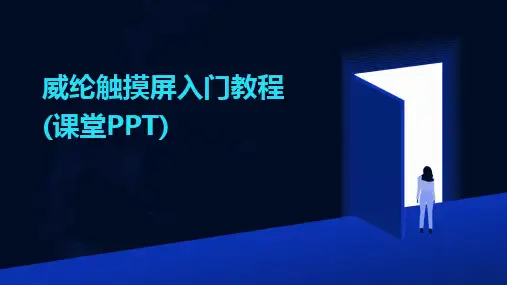
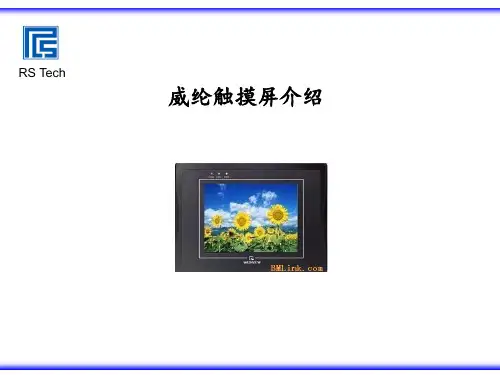

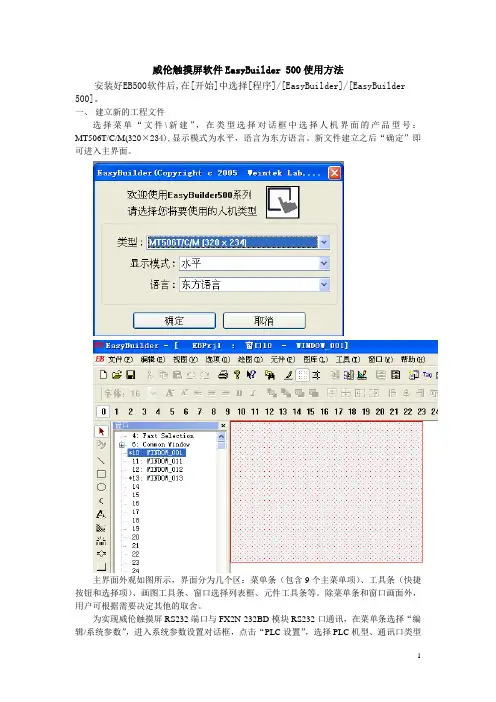
威伦触摸屏软件EasyBuilder 500使用方法安装好EB500软件后,在[开始]中选择[程序]/[EasyBuilder]/[EasyBuilder 500]。
一、建立新的工程文件选择菜单“文件\新建”,在类型选择对话框中选择人机界面的产品型号:MT506T/C/M(320×234),显示模式为水平,语言为东方语言。
新文件建立之后“确定”即可进入主界面。
主界面外观如图所示,界面分为几个区:菜单条(包含9个主菜单项)、工具条(快捷按钮和选择项)、画图工具条、窗口选择列表框、元件工具条等。
除菜单条和窗口画面外,用户可根据需要决定其他的取舍。
为实现威伦触摸屏RS232端口与FX2N-232BD模块RS232口通讯,在菜单条选择“编辑/系统参数”,进入系统参数设置对话框,点击“PLC设置”,选择PLC机型、通讯口类型及通讯参数,如下图所示。
完成后“确定”。
PLC端设置:新建工程后,点击左边工程数据列表中的参数选项—PLC参数(双击进入),点击PLC系统(2)菜单按下图设置。
设置完成后就可正常的编写PLC程序,在进行程序下载(写入PLC)时,选择PLC参数选项将刚设置好的参数一并下载。
以后改变PLC程序后下载时就不再选择PLC参数选项。
二、窗口画面设定窗口是EB500的工程的基本元素。
每个屏幕都是由一些窗口组成。
窗口有3种类型:基本窗口,公用窗口和快选窗口。
改变大小以后的基本窗口还可以当作弹出窗口使用。
所有的窗口都可以作为底层窗口。
基本窗口是通常窗口的类型。
当用”切换基本窗口”命令来切换基本窗口时,当前屏幕会清屏(除了公用窗口和快选窗口之外的窗口都会被清掉),而要切换的基本窗口会显示在当前屏幕上。
当基本窗口上的元件调用弹出窗口时,基本窗口的原始信息会保留,而调用的弹出窗口会附加到当前基本窗口上,所有的这样的弹出窗口与基本窗口都是父子窗口的关系。
当从基本窗口N切换到基本窗口M时,所有窗口N 的子窗口都将关闭,而显示窗口M和窗口M的子窗口。
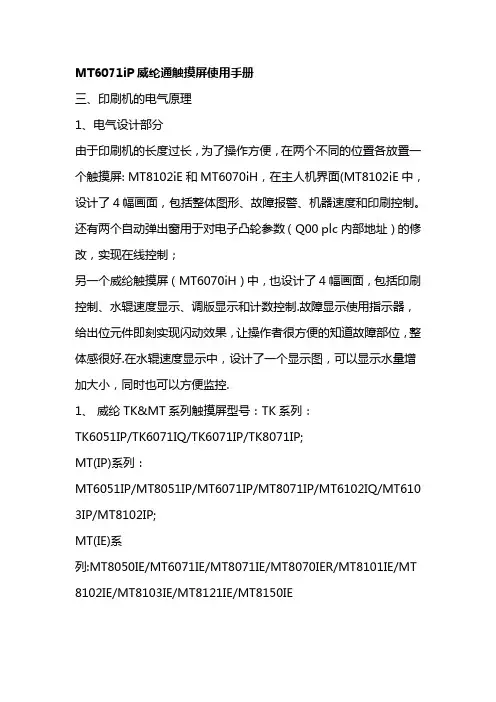
MT6071iP威纶通触摸屏使用手册三、印刷机的电气原理1、电气设计部分由于印刷机的长度过长,为了操作方便,在两个不同的位置各放置一个触摸屏: MT8102iE和MT6070iH,在主人机界面(MT8102iE中,设计了4幅画面,包括整体图形、故障报警、机器速度和印刷控制。
还有两个自动弹出窗用于对电子凸轮参数(Q00 plc内部地址)的修改,实现在线控制;另一个威纶触摸屏(MT6070iH)中,也设计了4幅画面,包括印刷控制、水辊速度显示、调版显示和计数控制.故障显示使用指示器,给出位元件即刻实现闪动效果,让操作者很方便的知道故障部位,整体感很好.在水辊速度显示中,设计了一个显示图,可以显示水量增加大小,同时也可以方便监控.1、威纶TK&MT系列触摸屏型号:TK系列:TK6051IP/TK6071IQ/TK6071IP/TK8071IP;MT(IP)系列:MT6051IP/MT8051IP/MT6071IP/MT8071IP/MT6102IQ/MT610 3IP/MT8102IP;MT(IE)系列:MT8050IE/MT6071IE/MT8071IE/MT8070IER/MT8101IE/MT 8102IE/MT8103IE/MT8121IE/MT8150IE威纶是威纶通的简称。
威纶通科技有限公司(WEINVIEW CO.,LTD)是集研发、生产、制造、销售于一体的人机界面供应商,基于先进的人机沟通技巧和品牌化发展理念,在生产自动化、过程自动化领域提供多种选择的优质人机界面产品、解决方案及服务。
WEINVIEW品牌专注于中国HMI市场,已广泛应用于机械、纺织、电气、包装、化工等行业。
我们的触摸屏4.3”—10”液晶屏幕的完整产品线:大小任选,提供4.3”—10”各种尺寸触摸屏;水平与垂直屏幕显示方向:垂直水平,屏幕显示方向可配合使用环境自由选择;IP65防护等级:所有机型都满足NEAM4/IP65防护等级可在0—50度下使用;PLC的连线功能:兼容市面上最常见的250款以上PLC/控制驱动,满足各种工业自动化需求;接口具有多组RS232/RS485 2W/4W,及USBHost/Client接口;USB Host接口即插即用,不仅可做工程上传和下载,以及资料的存储媒介使用,更可直接连接打印机、条码机、鼠标、PLC等用途品)。

利用威纶通MT8071ip触摸屏和英威腾GD10系列变频器通信为例介绍该功能的使用
变频器通常是利用面板进行参数设置,由于面板小巧按键不灵敏等原因造成输入不方便,可否直接用触摸屏与变频器通信实现参数设置功能呢?这里我们就利用威纶通MT8071ip触摸屏和英威腾GD10系列变频器通信为例介绍该功能的使用。
由于英威腾变频器只支持Modbus RTU通信协议,所以只能选用此协议通信。
建立触摸屏程序步骤如下:
1.选择触摸屏型号MT8071ip,如图1-1所示。
图1-1
2.添加通信连接点,PLC或仪表,此处为变频器。
上图中确定后弹出图1-2对话框,点击“新增”弹出图1-3,“PLC类型”选择MODBUSRTU(Adjustable),COM口参数跟变频器一致即可。
威纶通触摸屏:威纶通触摸屏是威纶通开发的电阻屏。
产品简介:威纶通系列全部型号触摸面板全线内置电源隔离保护器,支持MPI 187.5K连接,不用额外花费购买转换器;常规产品分辨率均为800×480以上,均采用EB8000同一套软件,具有强大的兼容能力,能适用于市面上95%常见的PLC、变频器、工控机等自动化设备。
威纶通所有型号均支持软件免费下载,且威纶通提供的软件全部都有正版授权,不用担心版权以及更新问题。
威纶通所有触摸屏均为电阻屏,因此在使用的时候需要用比较坚硬的物体来触摸操控。
公司简介:威纶通成立于1995年,它一个集生产、研发、销售触摸屏于一体的专业级品牌,1997年威纶通首度进入中国大陆,15年来,威纶通扎根于工业触摸屏,深耕细作,已经成为世界专业触摸屏的著名品牌,与同行业相比,已经连续5年销量第一。
产品系列:威纶通产品分i、X、MT和WT四个系列。
威纶通人机界面型号:TK6070iH,TK6102iV3,MT6100iV3,WT3010,MT506MV,MT6056i, MT6070iH,MT6100i,MT8070iH,MT8100i,MT8104iH,MT8104x, MT8121x,MT8150x。
威纶触摸屏:威纶是威纶通的简称。
威纶通科技有限公司(WEINVIEW CO.,LTD)是集研发、生产、制造、销售于一体的金牌人机界面供应商,基于先进的人机沟通技巧和品牌化发展理念,在生产自动化、过程自动化领域提供多种选择的优质人机界面产品、解决方案及服务。
WEINVIEW品牌专注于中国HMI市场,已广泛应用于机械、纺织、电气、包装、化工等行业公司发展:威纶通始终用最严格的标准鞭策自身发展:视品质为生命,采用世界先进的仪器设备,运用标准化作业程序执行管制;与国际标准同步,2004年通过国际知名认证公司SGS的9001-2000验证,2005年获得CE、UL、RoHS认证;做真正地球公民,在行业内率先采用符合先进环保标准的无铅零件和制造工艺,用实际行动为企业道德印上金牌品质保证,一路保持行业领先优势。